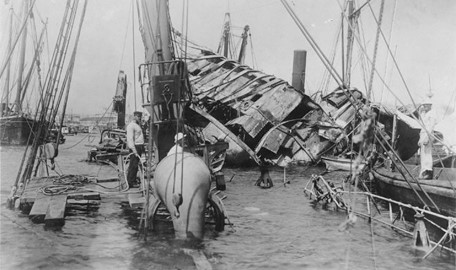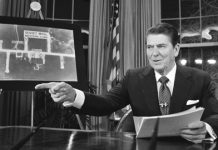On February 15, 1898, the U.S. battleship Maine blew up in Havana Harbor, escalating tensions with Spain and contributing to the outbreak of the Spanish-American War two months later.
The Sinking of the Maine
The USS Maine was stationed in Havana due to a prolonged conflict over Cuban independence. The United States supported the Cuban independence movement and due in part to America’s pressure Spain agreed to grant Cuba limited autonomy beginning Jan. 1, 1898. Later that month, riots broke out in Havana involving Cuban rebels and Spanish forces. U.S. President William McKinley ordered the Maine to Havana in mid-January to protect American interests.
On February 15, at 9:40 p.m., the ship mysteriously exploded. According to the U.S. Naval History & Heritage Command, “more than five tons of powder charges for the vessel’s six and ten-inch guns ignited, virtually obliterating the forward third of the ship. The remaining wreckage rapidly settled to the bottom of the harbor.” There were 260 men killed and six who suffered fatal injuries; just 89 men, most of them officers who were stationed closer to the rear of the ship, survived.
When the Maine exploded, suspicion immediately fell upon the Spanish. Senor Don Enrique Dupuy de Lome, the disgraced former Spanish Ambassador to the United States, declared that there was no chance of Spanish involvement and that the explosion was caused by an accident.
Regardless of the true cause of the explosion, the American public felt the Spanish were responsible and were outraged. Many adopted the rallying cry, “Remember the Maine! To hell with Spain!” Anti-Spanish sentiment was stoked by the American yellow press, particularly William Randolph Hearst’s The New York Journal and Joseph Pulitzer’s New York World, though the influence of the press has often been overstated.
The Navy investigated and concluded on March 28 that the Maine was destroyed by a mine, and though the report could not assign responsibility, it was presumed that it was carried out by the Spanish.
On April 11, McKinley asked Congress for permission to send troops Cuba. Congress consented and added an amendment stipulating that the United States would not seek to annex Cuba.
On April 21, McKinley ordered a blockade of Cuba. Spain declared war three days later and the United States did the same the following day.
Sources in this Story
- Library of Congress: World of 1898: The Spanish-American War
- U.S. Navy: Naval History and Heritage Command: The Destruction of USS Maine
- George Mason University: History Matters: Better Late Than Never?: Rickover Clears Spain of the Maine Explosion
- Encyclopedia Britannica: Spanish-American War
- HistoryNet (Military History): Spanish-American War: Battle of Manila Bay—Commodore Dewey’s Victory
- The Spanish-American War Centennial Website: Battle of Santiago
- The New York Times: War Suspended, Peace Assured
- National Endowment for the Humanities: EDSITEment: The Spanish-American War
The Spanish-American War
The Spanish-American War was a short war fought in the Caribbean and Pacific. “The ensuing war was pathetically one-sided,” according to Encyclopedia Britannica, “since Spain had readied neither its army nor its navy for a distant war with the formidable power of the United States.”
The first significant battle of the war occurred not in Cuba, but in the Philippines, where the United States decided to aid the Philippine Revolution against Spain. On May 1, U.S. Naval forces under Commodore George Dewey destroyed the entire Spanish fleet at Manila Bay in a matter of hours without a single American death. By August, the U.S. Navy seized Manila.
Fighting in Cuba was centered in the Spanish stronghold of Santiago de Cuba on the island’s southeast coast. In May, American Naval forces launched a blockade of the city’s harbor, where the Spanish fleet of Admiral Pascual Cervera was positioned. The two sides remained in a standoff for two months.
U.S. Army troops landed in Cuba in late June and marched toward Santiago. On July 1, U.S. forces, including Theodore Roosevelt’s famed Rough Riders, defeated the badly outnumbered Spanish forces at San Juan Hill and Kettle Hill outside Santiago. The United States then began a siege of the city.
America’s victory forced Cervera to attempt an escape from the harbor on July 3. His fleet was destroyed in the Battle of Santiago de Cuba. On July 16, just over two weeks into the siege, the city of Santiago agreed to surrender to U.S. forces, effectively ending the war.
The United States and Spain agreed to a ceasefire, signing the Protocol of Peace in Washington on August 12. It called for Spain to grant Cuba its independence and to hand over the Philippines, Puerto Rico and Guam to the United States.
The protocol also established the conditions for the negotiation of a formal peace treaty in Paris. The Treaty of Paris was signed on December 10, 1898, formally ending the war.
“With its victory in the Spanish-American War the United States claimed status as a global political-military power,” writes the National Endowment for the Humanities’ EDSITEment. “Secretary of State John Hay, in a mixture of pride and irony, termed it ‘a splendid little war.’”
This article was originally written by Denis Cummings; it was updated January 3, 2017.











